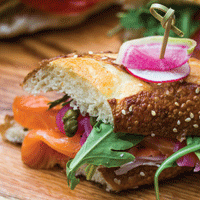Nothing says comfort like the tried-and-true pairing of a soup and sandwich. While the gourmet burger phenomenon skyrockets across Canada, foodservice operators are taking a bite back by upping the ante with new, gourmet soup-and-sandwich choices where, often, the diner gets to create their own bespoke meal in a market where freshness, quality, nutrition and value reign supreme.
Quick, Health-Conscious and Value-Driven
Healthy eats continue to drive the QSR soup-and-sandwich market. “We now have eight core menu items in Canada that are six grams of fat or less, and the nutritional values of many of our more indulgent items are quite favourable when compared to those from other chains,” says Chris Martone, executive chef of the U.S.-based Subway, which operates 2,700 locations throughout Canada. “Promotions and new product introductions often include a high percentage of healthier options.”
At Subway it’s all about offering value. For example, the suggested retail price for a soup is $2.29 per serving, with Cream of Broccoli, Roasted Chicken Noodle, Cream of Mushroom and Cream of Potato and Bacon accounting for 50 per cent of the chain’s soup sales alone. In 2008, the company reduced the sodium levels of its soups by 25 per cent, further reinforcing its healthy alternative angle. All soups, notes Martone, are pre-made at suppliers’ facilities and shipped to restaurants; the recipes are a collaborative effort between vendors and the internal R&D team.
Of course, guests are in the driver’s seat at this chain, but turkey and ham subs account for roughly 25 per cent of the chain’s sandwich sales. The latter two are part of the six grams of fat or less selections. The chain’s chicken-based subs are just behind the top three as the next bestsellers. Martone adds that egg salad was originally introduced at Subway restaurants in Canada as a limited-time offer and a value item, but it was so popular, it became permanent. “Our influences when creating food come from traditional home cooking to up-and-coming ingredients found in gourmet markets, to the ethnic diversities found throughout the world. We’re constantly evaluating the latest flavour trends and incorporating them into the Subway menu,” says Martone. In fact, the company is evaluating gluten-free products in a few test markets.
Similarly, at McDonald’s there’s a push towards healthier choices with three McBistro chicken sandwiches, offered grilled or deep-fried. And, a recent McDonald’s TV commercial shows actual employees dancing while preparing sandwiches that appear to be casual-dining, health-conscious options. The ad’s focus is on seasoned, grilled, all-white chicken breasts that sit atop whole-grain buns dressed with gourmet offerings. All sandwiches — the Swiss Mushroom Melt, the South West Chicken and the Chicken BLT — are priced at $5.19.
Tim Hortons, on the other hand, dedicates a menu section to ‘Sandwiches, Wraps and Hot Bowls.’ Any menu item with a green check lets customers know it contains eight grams of fat or less, and patrons customize it by selecting the bread size and type (small or large, white or whole-wheat homestyle bun), toppings and sauce.
Joel Gregoire, industry analyst, Food and Beverage, at The NPD Group says ham sandwiches remain the most popular amongst Canadians, with bacon sandwiches, such as the BLT, seeing growth in the past five years. This could explain why Tim Hortons offers bacon or ham in four of its eight sandwich selections; other menu options are predominantly chicken-based. And, every Tim Hortons offers a rotating roster of soups. Glenn Hollis, the company’s vice-president, Brand Marketing, says comfort in a bowl is the idea behind the soups with flavours such as Creamy Field Mushroom, Chicken Noodle and Hearty Vegetable. The latter two have three grams of fat for every 10-oz. serving and 29 per cent less sodium than they used to have.
“We hear: ‘Carry familiar and trusted soups and sandwiches and make it interesting for me with ins and outs that jazz things up and get a little daring,’” explains Hollis, which is why Tim Hortons offers a two-tier approach to higher-end soups, sandwiches and hot bowls. But, health and wellness, dietary needs, evolving tastes and demographics are driving new menu decisions like the panini. “These are exactly what our guests and the ‘burger-weary’ customers are begging for — to make lunch interesting again. We have varieties like Tuscan Chicken and Cheese, Tomato and Bacon,” Hollis says.
Full-Service Fast
The fast-casual/full-service segment offers diners ethnic flavours with more of a nutritional punch at a slightly higher price. “Customers are asking for healthy. Not just healthy as in salads and wraps, but [it’s about] what’s going into them,” says Matthew Corrin, CEO of the the international Freshii chain, which boasts a chef-designed menu. Top sellers include the pho-inspired, made-from-scratch Spicy Lemongrass Soup ($8.69) and the Vegan Wrap and Bangkok Burrito (both $7.49). Serv-ed on whole-wheat tortillas packed with fresh ingredients, the idea is to offer as much local product as possible, give it a gourmet twist and (once again) put the customer in the driver’s seat.
Corrin’s customers want to know which ingredients can make their meal healthiest. “They want to see unique ingredients, so we have focused on superfoods like kale and quinoa,” he says.
At Toronto’s Artisano Bakery Cafés the aroma of in-house bread baked daily, using in-house recipes, draws customers. Every soup is served with a wedge of bread to accompany its top-selling Italian Wedding soup, split pea and ham or cream of broccoli ($4.69 per bowl).
According to founder and co-owner Michael Simeone, one of the cornerstones of Artisano’s philosophy is to “Come up with unique menu items that you can’t see anywhere else. We grill our own chicken, steak and vegetables such as zucchini, eggplant and portobellos every day at every store.” The result is gourmet sandwiches such as grilled sirloin and portobello mushroom on Tuscan Filone bread ($10.49) or panini such as grilled chipotle chicken and avocado ($10.49).
Inspiration is drawn from customer requests and market trends. “We’re not bleeding edge, we’re cutting edge. We’re foodies of Italian heritage who grew up with good food all around us,” explains Simeone, adding that he works with his store managers to create new dishes such as the Islington store’s popular chickpea and quinoa salad (full size, $9.99; half size $6.99). And, gluten-free breads, pizza dough and desserts (such as chocolate banana pound cake), vegan sandwiches and soups are coming soon. But, next up are seafood sandwiches such as grilled Arctic Char.
Doing It Differently
Independents such as Calgary’s Boxwood café and O&B’s Bannock take a slightly different approach to soup and sandwiches. Both are equally quality-conscious, providing top product at good value, but neither claim to be health-driven.
Boxwood’s Kristi Peters Snider, the former 12-year GM at sister restaurant River Café and now marketing and communications assistant for both establishments, was part of the team that launched Boxwood. Here the chefs use made-from-scratch, artisanal products and local ingredients from farmers who practice responsible stewardship. “We highlight whole grains in side dishes and salads. We like to provide gluten-free options and experiment with recipes based on the demand of our clientele,” says Peters Snider.
At Boxwood, butchering, brining, curing and smoking products in-house is part of the preparation process, which is good, because Peters Snider is noticing a growing gourmet sandwich market, propelled by food trucks and rotisserie sandwich cafés such as Vancouver’s Meat and Bread. “Rotisserie meats, artisanal breads, specialty condiments and local ingredients put together make a fantastic sandwich,” she says. This could explain why Boxwood’s Bowden Farm Naturally Raised Rotisserie Chicken served on house-made ciabatta with a garlic scape and lemon preserve aioli ($11) is the restaurant’s most popular sandwich.
Like any dish, Boxwood’s soup choices continually evolve with the seasons. Favourites include the Bowden Farms chicken broth with caramelized onion and hand-torn noodles ($10) or the warm Lemon Lentil Dahl with spinach, cumin and coriander ($7). They’re made with fresh, local ingredients that admittedly challenge the budget, says Peters Snider.
Stephen Pynn, executive chef at O&B’s Bannock, echoes Peters Snider. “The challenge is using quality ingredients without relying on pre-processed/pre-packaged items while hitting our food cost and not gauging the customer, but rather, having them leave feeling they received value for their dollar.” The solution is to be smart and make sure quality ingredients are served and prepared so they’re accessible from a cost perspective, says Pynn of the restaurant that serves sandwiches such as a chicken caesar wrap, BLT and smoked salmon (each $8.41 to-go; $12 to $16 eat in). Pynn changes the soup variety daily, but customers’ favourites include the Chili Tortilla and Gazpacho Verde ($5 small, $8 large).
Whether guests eat in or buy from the “Grab-and-Go” counter, Pynn strives to make tasty, light meals for people on the move. “It’s got to be fresh, creative and delicious and that’s sometimes a challenge, but it’s always interesting,” he says.
Indeed, every restaurateur wants to hit upon the “lunchtime game changer,” providing value, a gourmet twist and a delicious reason for a return visit. Supporting local producers, creating artisanal products, injecting ethnic flavours into dishes and hitting upon health-and-wellness trends are vital to meeting demands most operators hope to extend well beyond the lunch rush.
Keep Reading
Rising to The Challenge: Discovering New Grains for Your Foodservice Operation




















